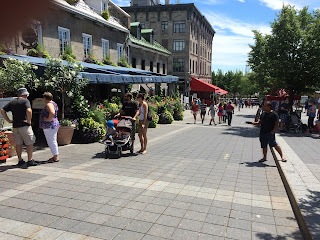Or stop for lunch in Saratoga Springs and make it 8 hours.
In Montreal, French is not an affectation, a cloak,
something the residents put on and take off as a reminder of their history and
heritage. Something to impress the tourists.
Montreal is totally French, spoken everywhere, written
everywhere, menus, street signs, store fronts, etc.
You are in France in many respects. As you walk by stores,
you have to look in the window to see whether it’s a restaurant or a grocery
store, a laundry mat or a vision center.
The only nod to English speakers is in the more touristy areas,
like Old Montreal, where you hear more English and there’s usually an English
version to whatever’s written, like on the menus.
Most of the residents
can speak English, and do so willingly I’ve found, but it usually comes with a
slight smile.
The people look and
dress different here. On the subway, I was struck by the mix of races, and
ethnics--Middle East, Asian, European, African, South American. Most of the
passengers were either wearing headphones that made them look like Martians or
looking at their phones which made them look normal.
We’re staying in a
residential part of Montreal, the Plateau, where we’ve rented a 2 bedroom flat
via Airbnb.
While it seems more
people here smoke, on the whole, people in Montreal seem fit, and thin.
The plateau section is hip, stylish, trendy, young, and happening.
There’s dozens of trendy bars, cafes and restaurants, all with open windows so
the noise, the talking, the music spills out on the streets like a welcoming
song. Off the main streets, the avenues are tree-lined, brick residential
houses with curved metal staircases to the second and third floors.
Montreal is
extremely bike friendly with clearly marked, designated paths on every street. You’ll
often find cars parked almost in the middle of the street because to park
against the curb would block the bike path.
Walking down Mont
Royal, one of the main drags here in the plateau, the other evening, I looked
down as some colorful pieces of paper blew across my path, like little bits of
litter. I reached down to grab it and suddenly realized it was money, Canadian
bills, 2 twenties and a five, that had fallen out of a man’s hand. I picked it
up just before another guy and quickly found the owner, a young man who seemed quite
grateful. The other guy asked the owner for the 5 dollar bill, and he gave it
to him. I guess he figured it was good luck.
You often see people
walking the streets carrying unopened bottles of wine, something Americans
would probably hide in a bag.
In one big open area,
there was this strange vehicle that had about a dozen people sitting on it,
each sitting over bike pedals. They were all talking and laughing, some kind of
pedal-powered party bus that road around town, some of the passengers dancing
in the aisle to the loud music it played.
Normally, if stranded
in center city Philadelphia, I wouldn’t know how to take the subway home if my
life depended on it. But we all ventured down into Montreal’s subway system to
visit Old Montreal. We each bought a 3-day pass for $18, which gives you
unlimited use of all public transportation for 3 days.
Old Montreal is the
more touristy part of the city, along the St. Lawrence River, and it’s
spectacular, with lots of narrow, curving cobble-stone streets lined with shops
and restaurants. Flowers are everywhere, adding a festive touch. There’s a walkway that runs right next to the
river where you can watch tour boats and other recreational boaters ply the
waters.
Last evening, after
walking all through Old Montreal, we came home and after a short rest, walked
down to Parc la Fontaine, an enormous park with gently rolling hills that sloped
down to a lake that snaked through the park. Although there were many people
picnicking on blankets, some barbecuing, some playing games, the park never
felt or looked crowded.
I’m told there are
tennis courts somewhere in the park, an activity for another day.
We ended the evening
at a crowded, small restaurant, where the main feature was poutine, French fries covered with fresh cheese curds, and topped with brown gravy. There are no limits to what can
be added to a basic poutine, vegetables, ground beef, pork, you name it. It
reminded me of how red beans and rice are a staple for dinner on Monday nights
in New Orleans, the tradition being that people had spent all their money
drinking on the weekends and needed some stick to your bones starch in their
bellies.
The profit margin on essentially
a French fry dinner must keep many restaurants in business.
Coming up, visits to
McGill University, Mont Royal, and an underground city of shops and restaurants,
the perfect place to spend a rainy day.








